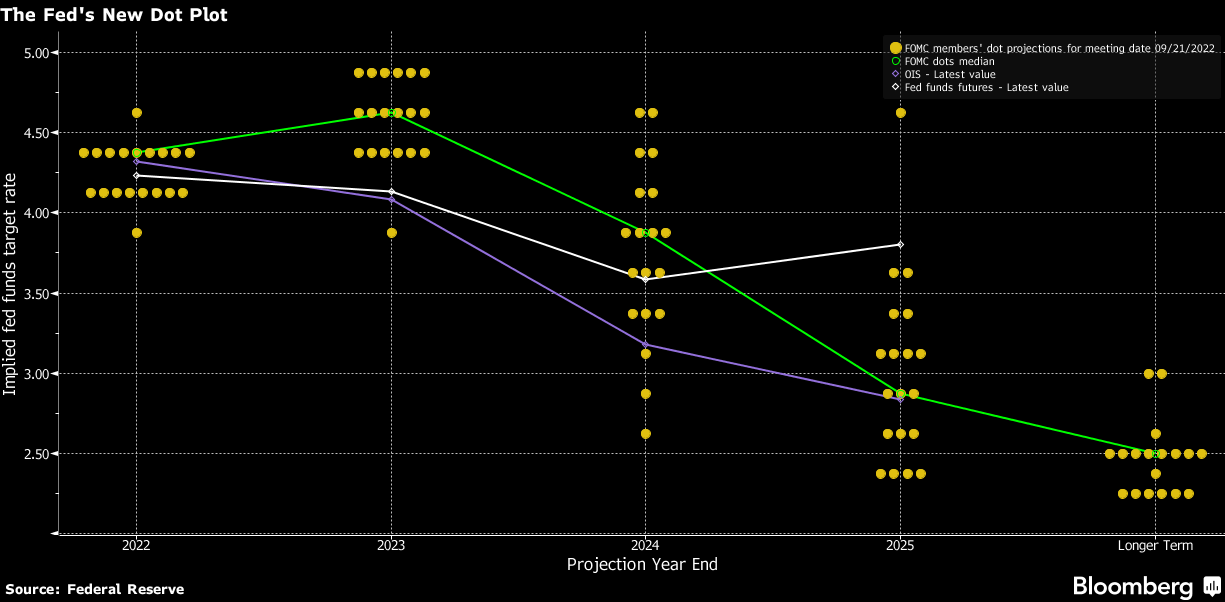The September rate hike came and went. In its wake, and following a wild afternoon trading session, stocks traded significantly lower. Fed Chairman Jerome Powell announced a 75 basis point hike yesterday (as expected) but the Fed also unveiled a very hawkish rate dot plot.

This caused stocks to plummet immediately after the hike was announced. Then, Powell’s post-FOMC press conference began and stocks rallied. The S&P was up as much as 1.30% higher on the day before cratering again.
All three major indexes finished with big losses and traded lower again this morning. The Dow, S&P, and Nasdaq Composite sagged through noon today as future rate hike concerns weighed heavily on investors. The market had a fed funds rate of 4.5% priced in for 2023 prior to the release of yesterday’s dot plot, which showed that the FOMC now predicts a fed funds rate of at least 4.6%. 2024’s median rate jumped much higher, too.
Stocks fell yesterday and again this morning as investors attempted to price that in, knowing that 2023’s anticipated rate could easily go above 4.6% in the Fed’s October meeting.
Powell’s press conference wasn’t all that hawkish, and that’s what caused stocks to rally sharply as he spoke. But his messaging remained consistent with his Jackson Hole speech, delivered late last month. Powell warned investors once again that the market needs to be prepared for a softer economy and higher rates for longer than previously expected.
The revised dot plot reflected that narrative.
“My main message has not changed since Jackson Hole,” Powell said.
“The FOMC is resolved to bring inflation down and we will keep at it until the job is done.”
Many analysts took Powell’s statements as a long-term sell signal.
“With the new rate projections, the Fed is engineering a hard landing – a soft landing is almost out of the question,” said Principal Global Investors Chief Global Strategist Seema Shah.
“Powell’s admission that there will be below-trend growth for a period should be translated as central bank speak for ‘recession.’”
Wall Street legend and activist investor Carl Icahn spoke about the rate hike in a morning interview.
“Inflation is a terrible thing,” he said, noting its role in bringing an end to the Roman Empire.
“You can’t cure it.”
Icahn continued:
“We printed up too much money, and just thought the party would never end. And the party’s over.”
He concluded by adding that “the worst is yet to come.”
Icahn said he agrees with the Fed’s decision to raise rates by 75 basis points but thought that a 100 basis point hike would have been more appropriate. The market remains split on whether the Fed should continue hiking aggressively to stop inflation or start hiking less to avoid deflation as the result of a grim recession.
Bond king Jeffrey Gundlach is in the camp that believes the Fed’s going too hard with its rate increases.
“Monetary policy has lags that are long and variable, but we’ve been tightening now for awhile,” he said. Gundlach also said that excessive tightening could lead to a recession.
News flash, Jeffrey:
The recession is already here. The US is on track for its third consecutive quarter of negative GDP growth. Gundlach would argue that the labor market is simply too strong for there to be a recession.
But the truth is that the jobs reports of the last few months have been total bunk. Private payrolls are up big (via the establishment survey) but the household survey has shown that US workers have plateaued. The reality is that Americans are now holding multiple full-time jobs at an unprecedented rate. This is driving the big monthly jobs gains.
Does that sound like the kind of thing that happens in a booming economy? Not at all. If anything, it resembles a third-world dystopia.
And so, there’s likely more pain for bulls in the coming weeks. The seasonal tendency for September is bearish, anyway. Stocks are adhering to their seasonal trend. Look for the market to bottom in October prior to another face-ripping bear market rally in November, when the seasonal trend recovers.
Will that mark the end of the bear market, though? Probably not. But it should give bulls at least a few weeks of happiness heading into the holiday season right around the same time the Fed uncorks another big rate increase.








